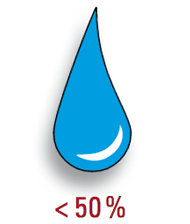
Factors of the indoor climate
Windows open, windows closed or air conditioning? Air conditioning in offices involves far more than temperature and fresh air. The following is a list of the most important factors.
Room temperature

A room temperature between 21°C and 22°C is recommended for office rooms. This temperature range is comfortable and promotes concentration.
The technical regulation ASR A3.5 "Room temperature" provides more detailed information. According to this, the temperature should not fall below a minimum of 20° C for predominantly sedentary activities with low physical strain (= office work).
The room temperature should not fall below 20°C. If outdoor temperatures are high, it can go up to 26°C. High room temperatures over long periods of time lead to tiredness and poor concentration.

During this time, the limits in ASR A3.4 may be lowered. In the meantime, a minimum temperature of 19°C applies for desk work.
Strong fluctuations of the temperature should be avoided. Temperature fluctuations may be due to the outdoor temperature, e.g. because of direct sunshine, or to the heat generated by technical devices. Strong temperature fluctuations in workplaces can be avoided through room-shading measures such as blinds and windows with solar-protection glass. Sometimes it is enough to air the room regularly and place the printer and copier in a separate room.

Recommendations for sun protection can be found in the publication of the German Social Accident Insurance DGUV Information 215-444 "Sonnenschutz im Büro" [Sun protection in the office", only available in German].

Recommendations on the subject of ventilation and aeration can be found in our "Belüftung" chapter [Ventilation, only available in German].
Surface temperature
Physical contact with surfaces that have poor heat conduction properties can lead to irritation. Consequently, glass plates are not suitable for use as desktops.
Humidity

Comfortable air quality in office rooms must be ensured for health reasons and also to promote people’s work performance. The relative humidity should be less than 50%, because higher values promote the development of mould.
Humidity can decrease to less than 30% during the winter heating period in particular. This can cause eye irritation and the drying-out of the skin and the respiratory tract. During the winter heating period, you should make sure that the rooms are adequately ventilated and that all the employees drink enough liquids.
Air quality
The main causes of poor air quality are, on the one hand, pollutants such as exhaust gases from construction materials and ozone and, on the other, smells that can be caused by insufficient ventilation. First results of poor air quality are tiredness and poor concentration.
Strict attention should therefore be paid to air quality as early as the construction planning phase. Office furniture materials are stringently regulated. Air conditioners can improve the indoor climate. Printers and copiers should be located in a separate room or at least be screened off from work areas.
Air velocity

At room temperatures of 20° C to 22° C, the air velocity in office rooms should be maximally between 0.1 m/s and 0.15 m/s. At higher temperatures, it may be useful to increase the air velocity for short periods of time. Velocities over 0.2 m/s for longer times should be avoided.

